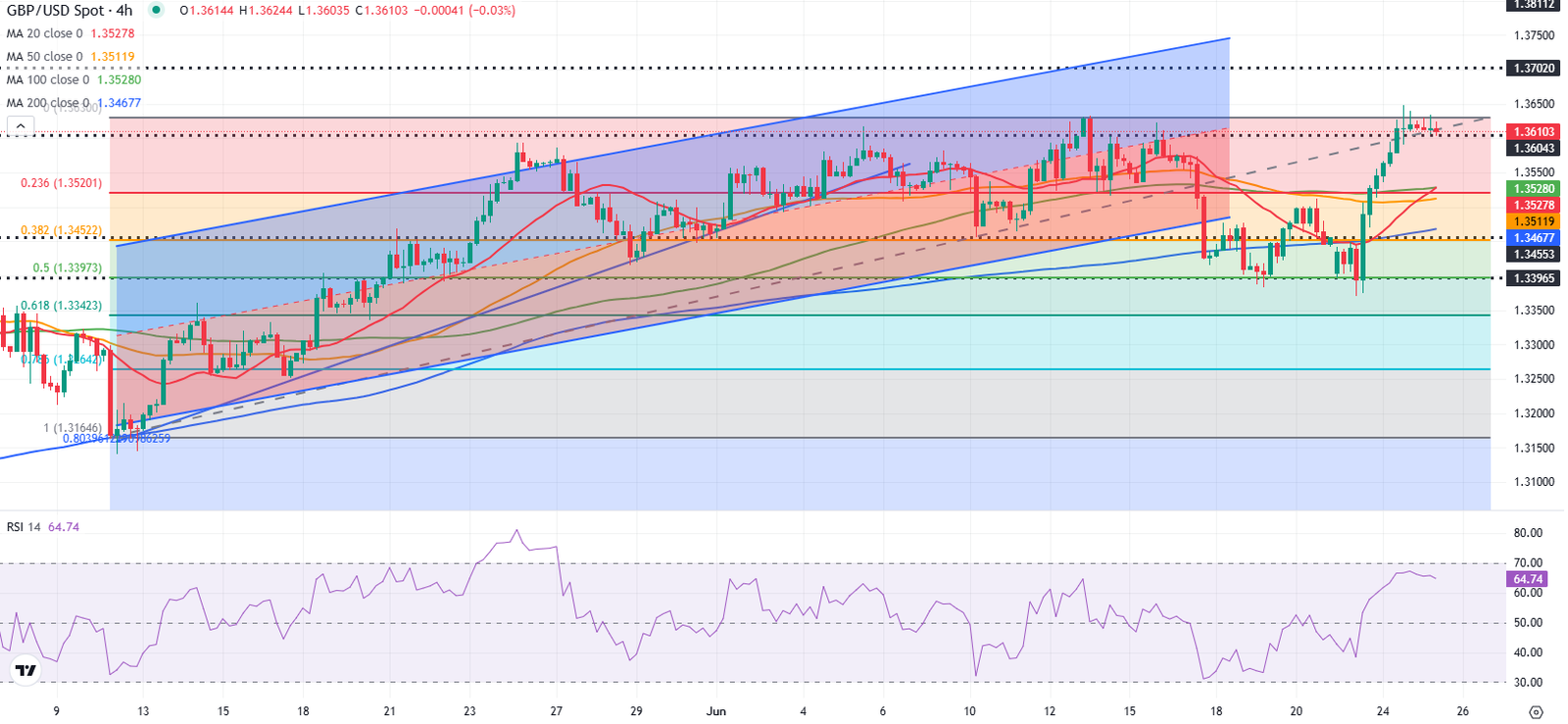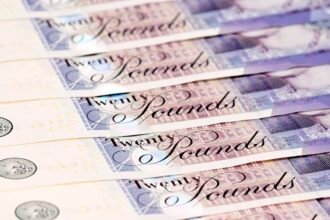- GBP/USD moves sideways slightly above 1.3600 on Wednesday.
- The pair could struggle to extend its weekly rally in case markets turn cautious.
- The technical outlook suggests that the bullish stance remains unchanged in the near term.
Following a late Monday rally, GBP/USD preserved its bullish momentum on Tuesday and reached its highest level since January 2022 near 1.3650. The pair stays relatively quiet early Wednesday and fluctuates in a narrow band slightly above 1.3600.
British Pound PRICE This week
The table below shows the percentage change of British Pound (GBP) against listed major currencies this week. British Pound was the strongest against the US Dollar.
| USD | EUR | GBP | JPY | CAD | AUD | NZD | CHF | |
|---|---|---|---|---|---|---|---|---|
| USD | -1.28% | -1.50% | -0.76% | -0.19% | -1.01% | -1.21% | -1.37% | |
| EUR | 1.28% | -0.26% | 0.56% | 1.10% | 0.22% | 0.07% | -0.13% | |
| GBP | 1.50% | 0.26% | 0.87% | 1.36% | 0.48% | 0.33% | 0.13% | |
| JPY | 0.76% | -0.56% | -0.87% | 0.54% | -0.29% | -0.40% | -0.70% | |
| CAD | 0.19% | -1.10% | -1.36% | -0.54% | -0.78% | -1.02% | -1.22% | |
| AUD | 1.01% | -0.22% | -0.48% | 0.29% | 0.78% | -0.17% | -0.35% | |
| NZD | 1.21% | -0.07% | -0.33% | 0.40% | 1.02% | 0.17% | -0.20% | |
| CHF | 1.37% | 0.13% | -0.13% | 0.70% | 1.22% | 0.35% | 0.20% |
The heat map shows percentage changes of major currencies against each other. The base currency is picked from the left column, while the quote currency is picked from the top row. For example, if you pick the British Pound from the left column and move along the horizontal line to the US Dollar, the percentage change displayed in the box will represent GBP (base)/USD (quote).
Risk flows continued to dominate the action in financial markets in the first half of the day on Tuesday as investors cheered news of the Iran-Israel ceasefire. As a result, the US Dollar (USD) struggled to find demand and allowed GBP/USD to push higher.
In the American session, Federal Reserve Chairman Jerome Powell’s cautious comments on policy-easing helped the USD find a foothold. Powell told the House Financial Services Committee that they are not in a rush to cut rates, noting that they expect a meaningful increase in inflation this year because of tariffs.
Meanwhile, Bank of England (BoE) Governor Andrew Bailey told the Lords Economic Affairs Committee on Tuesday that they are starting to observe labor market softening. Additionally, BoE Deputy Governor Dave Ramsden said that if evidence becomes stronger that inflation will undershoot the target, they can speed up rate cuts. Although these comments failed to trigger an immediate market reaction, they might be contributing to GBP/USD’s indecisive action midweek.
The economic calendar will not feature any high-impact macroeconomic data releases later in the day. Hence, investors could react to changes in risk perception. In case Wall Street’s main indexes correct lower following Tuesday’s risk rally, the USD could gather strength and make it difficult for GBP/USD to hold its ground.
GBP/USD Technical Analysis

The Relative Strength Index (RSI) indicator on the 4-hour chart holds above 60, suggesting that the bullish bias remains intact. On the upside, 1.3630 (static level) aligns as an immediate resistance level ahead of 1.3700 (static level, round level) and 1.3740 (static level).
Looking south, support levels could be seen at 1.3580 (static level), 1.3530 (100-period Simple Moving Average) and 1.3500 (static level, round level).
Pound Sterling FAQs
The Pound Sterling (GBP) is the oldest currency in the world (886 AD) and the official currency of the United Kingdom. It is the fourth most traded unit for foreign exchange (FX) in the world, accounting for 12% of all transactions, averaging $630 billion a day, according to 2022 data.
Its key trading pairs are GBP/USD, also known as ‘Cable’, which accounts for 11% of FX, GBP/JPY, or the ‘Dragon’ as it is known by traders (3%), and EUR/GBP (2%). The Pound Sterling is issued by the Bank of England (BoE).
The single most important factor influencing the value of the Pound Sterling is monetary policy decided by the Bank of England. The BoE bases its decisions on whether it has achieved its primary goal of “price stability” – a steady inflation rate of around 2%. Its primary tool for achieving this is the adjustment of interest rates.
When inflation is too high, the BoE will try to rein it in by raising interest rates, making it more expensive for people and businesses to access credit. This is generally positive for GBP, as higher interest rates make the UK a more attractive place for global investors to park their money.
When inflation falls too low it is a sign economic growth is slowing. In this scenario, the BoE will consider lowering interest rates to cheapen credit so businesses will borrow more to invest in growth-generating projects.
Data releases gauge the health of the economy and can impact the value of the Pound Sterling. Indicators such as GDP, Manufacturing and Services PMIs, and employment can all influence the direction of the GBP.
A strong economy is good for Sterling. Not only does it attract more foreign investment but it may encourage the BoE to put up interest rates, which will directly strengthen GBP. Otherwise, if economic data is weak, the Pound Sterling is likely to fall.
Another significant data release for the Pound Sterling is the Trade Balance. This indicator measures the difference between what a country earns from its exports and what it spends on imports over a given period.
If a country produces highly sought-after exports, its currency will benefit purely from the extra demand created from foreign buyers seeking to purchase these goods. Therefore, a positive net Trade Balance strengthens a currency and vice versa for a negative balance.





















